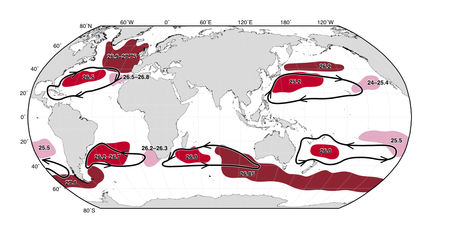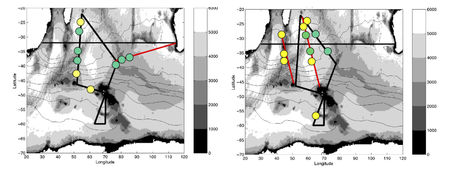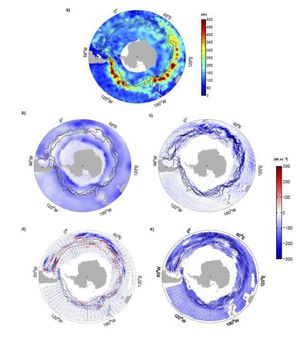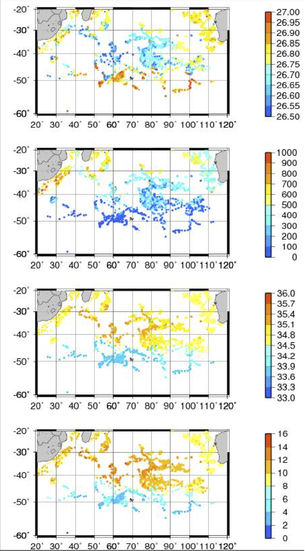FLOSTRAL is a joint-project from LEGOS, LBCM, UBO and LODYC French research centers to deploy an array of PROVOR profiling floats in 2003-2004 in the southwest Indian ocean. FLOSTRAL aimed to study the formation, circulation and modification of mode waters in the southern Indian Ocean.
Mode Waters from ARGO in the Southern Indian Ocean
by R. Morrow *(a), N. Metzl (b), G. Madec (c), S. Speich (d) and K.Speer (e)
* Corresponding author : Rosemary Morrow
(a): LEGOS Toulouse, France
(b) : LBCM Paris, France
(c) : LODYC Paris, France
(d) : LPO University of Brest, France
(e) : Florida State University, USA
FLOSTRAL is a joint-project from LEGOS, LBCM, UBO and LODYC French research centers to deploy an array of PROVOR profiling floats in 2003-2004 in the southwest Indian ocean. FLOSTRAL aimed to study the formation, circulation and modification of mode waters in the southern Indian Ocean. With this perspective, a combination of satellite, in situ observations and numerical model outputs were analysed. Thirty profiling PROVOR floats were deployed in 2003-2004 in the framework of the international ARGO programme, financed by INSU and CORIOLIS. The scientific results were supported by the French GMMC and PATOM projects. The FLOSTRAL project is also integrated in the international CLIVAR programme.
Scientific Interest
The southern region of the Indian Ocean has been identified as an important formation region for subantarctic (SAMW) and subtropical (STMW) mode waters. These water masses are formed by subduction in the deepest winter mixed layers of the Antarctic Circumpolar Current (ACC). They are relatively cold and fresh homogeneous waters with low potential vorticity and a high CO2 content (Sallée et al, 2006). Their formation zone (fig.1) stretches from the southeast Indian Ocean right across the South Pacific Ocean, and even into the southwest Atlantic just east of Drake Passage.
Once formed in the deep winter mixed layers, these mode waters are then subducted in late winter and plunge into the subtropical gyres. As they have a high CO2 content, they are strong indicators of climate change variability and carbon uptake. As they recirculate at depth within the subtropical gyres, their properties are gradually modified so that they become slightly warmer and saltier when they exit the subtropical gyre south of Africa.
Figure 1 : Scheme of mode water distributions in the world’s oceans, from Hanawa and Talley (2001). Brown : SAMW and Subpolar MW ; red : Subtropical MW ; purple : Subtropical East MW.
The main objective of the FLOSTRAL project is to further understand the mechanisms that govern the formation and circulation of SAMW/STMW and how their water mass characteristics are modified during their circulation. With this aim, an essential element is to establish a network of PROVOR profiling drifters in the southern Indian Ocean in 2003-2004, in order to monitor and quantify the recirculation of Antarctic Intermediate Water (AAIW) and SAMW/STMW.
Data and Methodology
The first 15 profiling floats were launched during the FLOSTRAL-I programme in January 2003 during the Marion Dufresne’s regular transit around the French subpolar Islands in the southern Indian Ocean. The second group of 15 profiling floats were launched during FLOSTRAL-II from the Marion Dufresne in January and April 2004 in the southern-west Indian Ocean. All of these profiling floats, inactive today, were programmed to cycle every ten days with a profiling depth to 2000m and a parking depth at 500 or 1900m.
Figure 2 : ARGO float deployments during FLOSTRAL-I (left) and FLOSTRAL-II (right). Parking depth at 1900m for floats at yellow points, parking depth at 500m for floats at green points. (black line) : initial and (red line) : modified route of the Marion Dufresne during the campaigns The black solid line at 32°S represents the line chosen for the deployment of 25 Argo/UK floats in 2002.
Scientific Results
Scientific studies on the formation and circulation of mode and intermediate waters in the southern Indian Ocean have been made possible due to the extensive coverage of ARGO - and including FLOSTRAL - data. Argo float data from 2003 were first used to determine the water mass characteristics of the deep winter mixed layers in the southern Indian Ocean. There, FLOSTRAL data show (fig.3a) very deep winter mixed layers (300-500m depth) during the winter 2003-2004 in the region [80-110°E;45°-55°S], north of the SAF and south of the STF. SAMW formed in this region have distinct water mass properties, known as SouthEast Indian SAMW (SEISMAW). A mixed-layer heat budget calculated for the winter period over the entire Southern Ocean, using a combination of ARGO and satellite data, led to the conclusion that there was a primary balance between air-sea fluxes and Ekman transport (Sallee et al., 2008a). However, the regions of deep mixed layers (fig.3a) are spatially limited because the eddy heat diffusion limits the deepening of the mixed layer (fig.3d), especially in the western boundary regions (Sallee et al., 2008c).
The ARGO floats - including the FLOSTRAL floats - also give us precious information about the mode water properties after subduction, after they have left the mixed layers. We can track the position of the mode water layer by its characteristic signature with a minimum in potential vorticity. The water mass characteristics shown for the minimum potential vorticity layer are shown for the southern Indian Ocean in figure 4. There is a clear evolution of the hydrological characteristics in the direction of the flow of subtropical gyre. Waters formed in the winter mixed layer north of the SAF around 47°S are subducted east of Kerguelen, and are then advected north then west within the subtropical gyre. The subducted mode waters become increasingly warm and salty towards the west, until they reach the Agulhas Current in the west, with an average depth of 600 meters and a density of 26.75 (fig.4).
Figure 3 : (a) Winter mixed layer depth in the Southern Ocean from Argo and ship data. b) Climatological winter, air-Sea heat exchange, (c) Ekman heat advection, (d) Eddy heat Diffusion in the mixed layer and (e) the total of these three components. Contours represent the mean ACC fronts (PF, SAF and SAF-N) ( from Sallee et al., 2008a)
Figure 4 : Maps of mode waters density(a), depth (b), salinity (c) and temperature (d) derived from FLOSTRAL profiling float data in 2003, at the potential vorticity minimum point.
This precise knowledge of ocean’s vertical structure from these FLOSTRAL observations is also being used to validate ocean general circulation models, a necessary step to evaluate a model’s realism, before they are analysed further for studying the full spatial and temporal evolution of the mode waters properties over a longer period. This validation process, performed by Koch-Larrouy et al. 2010, led to a better understanding of where the model’s mode water circulation was realistic.
References
- Boutin, J. ; Merlivat, L. ; Hénocq, C. and Sallée, J.B., 2007 : Air-sea CO2 flux variability in frontal region of the Southern Ocean from CARbon Interface OCean Atmosphere drifters, Limnol. Oceanogr., 2008, 53, 2062-2079. 2007
- Hanawa, K. and L. D. Talley, 2001 : Mode Waters. Ocean Circulation and Climate, G. Siedler and J. Church, editors, International Geophysics Series, Academic Press, 373-386.
- Koch-Larrouy, A., R. Morrow, T. Penduff, M. Juza, 2009 : Origin and mechanism of Sub Antarctic Mode Water formation and transformation in the Southern Indian Ocean, Ocean Dynamics, doi:10.1007/s10236-010-0276-4
- Morrow, R. ; Valladeau, G. and Sallée, J.B. Observed subsurface signature of Southern Ocean decadal sea level rise Prog. Oceanogr., 2008 , 77(4), 351-366
- Sallée, J.B. Les eaux modales de l'Océan Austral (Southern Ocean Mode Waters), Ph.d Thesis, Toulouse University, 2007
- Sallée, J. B., N. Wienders, K. Speer, and R. Morrow, 2006: Formation of subantarctic mode water in the southeastern Indian Ocean. Ocean Dynamics, 56, 525-542.
- Sallée, J. B., K. Speer, and R. Morrow, 2008a : Response of the Antarctic Circumpolar Current to atmospheric variability. Journal of Climate, 21(12), 3020-3039.
- Sallée, J. B., R. Morrow, and K. Speer, 2008b : Eddy heat diffusion and Subantarctic Mode Water formation. Geophysical Research Letters, 35, L05607, doi:10.1029/2007GL032827
- Sallée, J.B.; Speer, K.; Morrow, R. and Lumpkin, R., 2008c : An estimate of Lagragian eddy statistics and diffusion in the mixed layer of the Southern Ocean, Journ. of Marine Res., 66(4), 441-463




